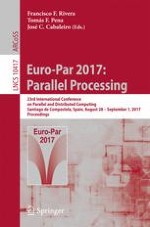This book constitutes the proceedings of the 23rd International Conference on Parallel and Distributed Computing, Euro-Par 2017, held in Santiago de Compostela, Spain, in August/September 2017. The 50 revised full papers presented together with 2 abstract of invited talks and 1 invited paper were carefully reviewed and selected from 176 submissions. The papers are organized in the following topical sections: support tools and environments; performance and power modeling, prediction and evaluation; scheduling and load balancing; high performance architectures and compilers; parallel and distributed data management and analytics; cluster and cloud computing; distributed systems and algorithms; parallel and distributed programming, interfaces and languages; multicore and manycore parallelism; theory and algorithms for parallel computation and networking; prallel numerical methods and applications; and accelerator computing.
